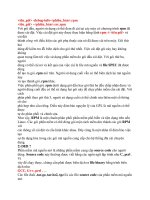IT 17 023 EXAMENSARBETE 45 HP JUNI 2017 MOBILE SOCIAL NETWORK PLATFORM
Bạn đang xem bản rút gọn của tài liệu. Xem và tải ngay bản đầy đủ của tài liệu tại đây (1.02 MB, 65 trang )
IT 17 023
Examensarbete 45 hp
Juni 2017
Mobile Social Network Platform
Lei Sun
Institutionen för informationsteknologi
Department of Information Technology
Teknisk- naturvetenskaplig fakultet Abstract
UTH-enheten
Mobile Social Network Platform
Besöksadress:
Ångströmlaboratoriet Lei Sun
Lägerhyddsvägen 1
Hus 4, Plan 0 The SWiN project is an abbreviation for Social Wireless Network Secure
Identification project and it primarily focuses on the security issues of social networks
Postadress: on mobile platforms. This master thesis is a part of the SWiN project from SICS
Box 536 (Swedish Institute of Computer Science) in cooperation with Ericsson and Sony.
751 21 Uppsala In this thesis project, we have designed and implemented a social networking
prototype called FriendFinder. This prototype integrates different security solutions
Telefon: such as SAML and GBA to test the performance of them.
018 – 471 30 03
Telefax:
018 – 471 30 00
Hemsida:
/>
Handledare: Ludwig Seitz
Ämnesgranskare: Justin Pearson
Examinator: Mats Daniels
IT 17 023
Tryckt av: Reprocentralen ITC
Contents
Acknowledgements ....................................................................................................................................... 7
List of Abbreviations...................................................................................................................................... 8
Chapter 1 Introduction.................................................................................................................................. 9
1.1 Introduction of SWiN Project .............................................................................................................. 9
1.2 Motivation of My Thesis.................................................................................................................... 10
1.3 Scope of Thesis .................................................................................................................................. 10
1.4 Development Process Model ............................................................................................................ 11
1.5 Thesis Organization ........................................................................................................................... 12
Chapter 2 Background................................................................................................................................. 13
2.1 FriendFinder ...................................................................................................................................... 13
2.2 Location‐based Social Networks ....................................................................................................... 13
2.3 GBA .................................................................................................................................................... 14
2.3.1 Introduction of GBA.................................................................................................................... 14
2.3.2 Elements of GBA......................................................................................................................... 15
2.3.3 Work Flow of GBA ...................................................................................................................... 15
2.4 Certificate & SAML ............................................................................................................................ 16
2.4.1 Introduction of SAML ................................................................................................................. 17
2.4.2 SAML Assertion........................................................................................................................... 17
Chapter 3 Methods and Techniques Required............................................................................................ 19
3.1 Android .............................................................................................................................................. 19
3.2 SQLite ................................................................................................................................................ 19
3.3 MySQL................................................................................................................................................ 20
3.4 Glassfish............................................................................................................................................. 20
3.5 REST ................................................................................................................................................... 21
3.6 Jersey................................................................................................................................................. 21
3.7 Maven................................................................................................................................................ 21
3.8 SVN .................................................................................................................................................... 22
Chapter 4 Implementation .......................................................................................................................... 23
4.1 Social Networking Module ................................................................................................................ 24
4.1.1 Requirement Specification ......................................................................................................... 25
5
4.1.2 UI Design..................................................................................................................................... 28
4.1.3 FriendFinderLibs ......................................................................................................................... 35
4.1.4 Local Database Design................................................................................................................ 38
4.2 FriendFinder Module......................................................................................................................... 41
4.3 Authentication Module ..................................................................................................................... 41
4.3.1 Introduction of MWSB................................................................................................................ 41
4.3.2 MWSB Enabler Architecture....................................................................................................... 42
4.3.3 Procedures of MWSB ................................................................................................................. 42
4.3.4 Implement MWSB on FriendFinder Application ........................................................................ 44
4.5 REST Implementation ........................................................................................................................ 50
Chapter 5 Conclusion and Future Work ...................................................................................................... 62
Reference .................................................................................................................................................... 64
6
Acknowledgements
I would like to thank my supervisor Ludwig Seitz for guiding my thesis study. I want to thank
Christian Gehrmann for the support. In addition, I want to say thanks to my thesis reviewer Olle
Eriksson and Justin Pearson for their guidance. Thanks to Oscar Ohlsson from Ericsson for help
with GBA. Finally, I would like to thank everyone who offered me help during my thesis project.
7
List of Abbreviations
GAA Generic Authentication Architecture
GBA Generic Bootstrapping Architecture
B‐TID Bootstrapping Transaction Identifier
IMPU IP Multimedia Public Identity
HLR Home Location Register
HSS Home Subscriber Server
MSNP Mobile Social Networking Provider
MWSB Mobile Web Security Bootstrap
NAF Network Application Function
PKI Public Key Infrastructure
8
Chapter 1 Introduction
The chapter describes the current state of the SWiN project as well as outlines the motivation
and scope of this thesis.
1.1 Introduction of SWiN Project
The SWiN project is an abbreviation for Social Wireless Network Secure Identification project.
SWiN primarily focuses on the security issues of social networks on mobile platforms. This
master thesis is a part of the SWiN project from SICS (Swedish Institute of Computer Science) in
cooperation with Ericsson and Sony.
From the end of the 1990s, the rapid increase of social networking services has had a profound
effect on communication. Virtual socializing has become a major trend to keep in touch with
friends, family, and even strangers. No matter where people are they can access social
networks via their mobile phones. When people turn on their computers, the first thing that
they do might be browsing social networking websites. It is no surprise that social networks play
a very important role in our daily life.
In recent years, the social network is moving into mobile domain due to the rapid development
of smartphones. Social networking providers start to offer new functions by incorporating
mobile features. For example, due to the availability of GPS in smart mobile phones, social
networks based on geographic location are becoming popular. For example, users can check
into place and share their location with other users. It is also possible to search for bars or
restaurants nearby. These exciting features provide a new kind of user experience; they also
result in a higher risk of leaking privacy. Most users would probably not like strangers to know
where they are and what they are doing. Consequently, how to protect integrity and
confidentiality of personal data from illegal data collection becomes an important factor to
improve the quality of social networking services [14].
Social networks adapted to mobile platform increases the possibility of leaking users’ private
data in mobile phones. On the other hand, it also provides an alternative to protect personal
data by integrating security features from the mobile phone. The SWiN project addresses the
question of how to improve existing and upcoming mobile security technologies such as USIM,
ISIM, GBA in order to enhance the mobile user’s security experience [1]. Besides this, it also
proposes effective security solutions that guarantee confidentiality of the communication
between clients without social networking provider interaction. For example, when users create
a group and communicate directly with each other over NFC or Bluetooth, the communication
among group members should be confidential and protected from leakage to unauthorized
users.
9
So far, the project mainly concentrates on three issues and puts forward three related solutions.
The first one is how the server authenticates users which is an essential requirement for secure
service. The second one is how to preserve the privacy and personal integrity of the user in a
mobile social network. The last one is to improve the Android security which is originally only
based on a simple access control model. But this thesis only pays attention to the former two
issues. Regarding the last one refer to Qing Huang’s thesis [2].
1.2 Motivation of My Thesis
Theoretical security solutions for mobile social networks have been proposed in the previous
research of the SWiN project [1]. There is now a need for a social networking application that
can integrate and test the proposed security solutions. The application needs support for
common social networking features.
In the first part of the thesis, we will implement a social networking application that fulfills
these requirements. The application will be called FriendFinder. It will contain a service provider
and a client. The client will be running on the Android operating system.
In the second part of the thesis, we will integrate and evaluate the security solutions proposed
by the SWiN project.
This application is not intended for commercial use. Therefore, it aims to provide basic social
networking functionalities before pretty user interface and advanced features. The application
will still be highly extensible and well documented.
1.3 Scope of Thesis
The scope of the thesis primarily consists of:
Study the SWiN project’s background and understand the security problems it addresses
and the solutions it proposes.
Design and implement a social networking client in Android with typical social
networking features.
Design and implement a social networking server.
Integrate and validate the security mechanisms from the SWiN project in the social
networking client/server.
10
Document findings.
1.4 Development Process Model
We adopted a sequential design process, the waterfall model, to develop this software. For
each stage, we made a concrete plan with time schedule to ensure that we were able to
complete the software with high quality on time. The details of the process are described below.
1. Requirements
The first essential stage was to set the requirements of the software. In order to draw up a
reasonable and comprehensive requirement specification, background investigation was our
main task in the first month. We concentrated on understanding the background of the SWiN
project and figuring out the issues that the SWiN project has addressed and solutions it has
introduced.
Because the system is used as a demonstrator for validating security solutions, it is designed to
provide enough social networking scenarios that are needed for testing security strategies. In
this stage, we have conceived all use cases and finished a strict requirement specification.
2. Design
The following month, we started designing the system architecture and created a system model
in UML (Unified Modeling Language).
3. Implementation
The Implementation took us approximately 4 months. It was divided into two parts: the server
and the client. The main task in this stage was to implement the code in each side and to follow
the previous design. Moreover, both the client and server were shipped with the security
solutions from SICS and Ericsson Lab.
4. Verification
During the implementation phase, we debugged the system in parallel. For each functional
increment, our supervisor tested the system and gave us feedback. At this stage, the system
was moved from development environment into the real environment to test if it satisfied the
demands. We moved the finished software from emulator into mobile phone to test it in reality.
11
5. Maintenance
After implementation and verification, the last task was to write related documentation and
fixed newly found defects. At the same time, we also started to write the report of thesis.
1.5 Thesis Organization
Chapter 1 is the introduction of this thesis which includes background and motivation. Chapter
2 covers more details of the SWiN project. Chapter 3 describes the methods and techniques
which were used in implementation and the reasons why we decided to use them. Chapter 4
illustrates the details of the implementation. I was mostly responsible for the client part so my
statement will focus on the client side. Chapter 5, the last chapter of this report, makes a
conclusion of the whole thesis work and proposes future work.
12
Chapter 2 Background
This chapter introduces the background of FriendFinder which contains its design concept,
initial intention and security mechanisms from the SWiN project.
2.1 FriendFinder
We implemented a social networking application called FriendFinder which is regarded
as a test platform for security solutions. The main feature in FriendFinder is like the
name suggests to find the location of your friends. This category of service is called
location‐based social networking service. It allows users to send messages and share
their location by connecting with a server or direct communication such as WIFI, NFC or
Bluetooth.
2.2 Location‐based Social Networks
In the beginning, location‐aware mobile applications allowed mobile phone users to
view the current location of their friends. This kind of location‐based service merely
shared the location among friends. It didn’t provide any functionality for users to
interact with the environment. An example of an application from this time is Google
Latitude, where a user's cell phone location was displayed on Google Maps. Other users
can see the location instantaneously. In order to preserve privacy, a user can specify a
group of people that are allowed to see the location. It is also possible to turn off the
service completely. Moreover, a user also can control the accuracy of what each of the
other users are authorized to see [15].
The next generation of location‐based social networking services expands this idea and
allows users to interact with their environment through mobile devices. Foursquare is a
location‐based social networking website for mobile devices. Users "check in" at venues
using a mobile website, text messaging or a device‐specific application by selecting from
a list of venues the application locates nearby [4]. Then they could recommend
restaurants, pubs, and other places around “check in” venues or check the
recommended places by other users. The second generation of location‐based service
discloses more sensitive user data, not only the location. It might also reveal a user’s
habits, customs, characteristics, personalities and such kind of information. With
bringing new fantastic functionalities, it also has increased security requirements.
The data could be manipulated to reconstruct a real person’s life easily. A mobile social
13
network user has to worry about being overseen or stalked by an adversary. Apart from
this concern, an adversary can impersonate the user by falsifying or stealing private
data from social networking providers. Another similar attack is “man‐in‐the‐middle”. It
is possible when the system lacks mutual authentication so that an attacker can
impersonate each endpoint. The entire conversation is controlled by attacker and it is
rather easy to gain the private information from victims.
The FriendFinder application supports direct communication which enables
information exchange between clients by using short‐range wireless technology such as
Bluetooth or WIFI. For example, a user could establish a group and send invitation to
friends by Bluetooth or WIFI. Then they can share locations among members in this
group. In this scenario, the attacks mentioned before such as “man‐in‐the‐middle” and
spoofing are also existed. Additionally, eavesdropping should be considered as well.
The eavesdropping issue may rise a reply attack. Besides this, there is another issue
that has to be considered. A user in one social network will play a certain role with
corresponding privilege such as group administrator, group owner or common
member. It shall not be allowed that a common member pretend to be a group owner
and proceed some activities which are only permitted by group owner. In direct
communication by WIFI or Bluetooth scenario, how to distinguish the roles of each user
and ensure a user is only allowed to perform authorized activities will be also
addressed in this project.
This project will provide two authentication and identification strategies. One is used for
interaction between social networking provider and users. Another one is used among
social networking users themselves.
2.3 GBA
This technology uses the characteristic of mobile phones to implement authentication. It
effectually prevents illegitimate users getting access to the system. The authentication
mechanism will be launched when a user tries to log in.
2.3.1 Introduction of GBA
During the communication between a server and a client, it uses GBA [5] (Generic
Bootstrapping Architecture) which is standardized at the 3GPP to authenticate a user.
14
The theory of GBA is based on a shared secret key which is integrated in the sim card
and also in the HLR (Home Location Register)/HSS (Home Subscriber Server).
Therefore, a prerequisite to launch GBA protocol in practice is that a user owns a valid
identifier on HLR or HSS. GBA authenticates the sim card by making a network
component challenge. The sim card will respond to the challenge and the response
will be compared with the correct answer in HLR/HSS [5].
2.3.2 Elements of GBA
The actors in GBA are listed together with their main responsibilities:
BSF: Bootstrapping Server Function is used for mutual authentication between UEs and
service providers [16].
HSS: Home Subscriber Server is a database that stores user profiles [17].
SNP: Social Networking Provider, it is a provider which offers relative social networking
services.
UE: User Equipment, such as a mobile phone.
2.3.3 Work Flow of GBA
Figure 2.3.3.1 [1]
15
Figure 2.3.3.1 shows the workflow of GBA. Below are more detailed steps that explain
how an untrusted UE is authenticated through GBA:
1. An untrusted UE tries to access a social network, social networking provider refers
the UE to BSF.
2. UE and BSF are mutual authenticated with each other and bootstrap GBA.
3. BSF queries HSS to retrieve the UE’s profile including a secret session key.
4. The UE uses the secret session key to answer the challenge from social networking
provider.
5. Social networking provider connects with BSF to verify if the response is correct.
6. Depending the result of the verification, the social networking provider decides
to let the UE access social network or not.
As a result of successful bootstrapping, a secret key is shared between the UE and the
social networking provider. The shared key is only valid for a certain time period.
2.4 Certificate & SAML
The problem with authentication between an online social networking provider and a UE
has been solved by integrating GBA. However, the authentication problem still remains
for the case where two social networking users communicate directly with each other
over WIFI or Bluetooth. We assume Internet connection is not available in this case. Our
concerns focus on the mutual authentication among users. How could we carry out a
reliable authentication? Before figuring this question out, it is essential to first find out
what should be authenticated for a social networking user.
1. Ensure that a user is a valid member in the group.
2. Ensure that the right of one user is in accordance with the user’s role.
The first concern was solved by importing a certificate issued by a trusted CA. Users in
social networks should possess a valid certificate locally, for example storing
certificates in mobile phones. Therefore, users can prove who they are through loading
16
certificates to the service provider. In this project, the certificate uses the X.509
certificate standard.
For resolving the second concern, standard SAML has been engaged.
2.4.1 Introduction of SAML
SAML (Security Assertion Markup Language) has been selected to assist users to identify
each other. It is a product of the OASIS Security Services Technical Committee which is a
XML‐based open standard for exchanging authentication and authorization data between
security domains, that is, between an identity provider (a producer of assertions) and a
service provider (a consumer of assertions) [6]. For example, in our case, one user acts as a
WIFI sponsor to provide others a private channel to join. This user is regarded as a service
provider and the others who tries to join is identity provider. An identity provider has to
supply identification to the service provider. The identification is made up by SAML.
2.4.2 SAML Assertion
SAML defines XML‐based assertions and protocols, bindings, and profiles [6]. In this
project, we only consider using SAML assertion. The assertion contains statements
and the service provider will make access‐control decisions based on it. There are
three sorts of statements: [6]
1. Authentication statements
2. Attribute statements
3. Authorization decision statements
Authentication statements assert to the service provider that the principle did indeed
authenticate with the identity provider at a particular time using a particular method of
authentication [6].
An attribute statement asserts that a subject is associated with certain attributes which
is simply a name‐value pair in common. The service provider makes access‐control
decisions relying on attribute [6].
An authorization decision statement asserts that a subject is permitted to perform
action A on resource R given evidence E. The expressiveness of authorization decision
statements in SAML is intentionally limited [6].
17
Here is the attribute statement that satisfies our requirements:
<saml:Assertion A>
<Issuer> B </saml:Issuer>
<Subject> C </saml:Subject>
<AttributeStatement>
<Attribute Name=" D ">
<AttributeValue> E
</AttributeValue> </Attribute>
</AttributeStatement>
</saml:Assertion>
The fragment of above simple SAML attribute assertion represents that:
1. Assertion A is issued by Issuer B regarding Subject C.
2. Subject C owns an attribute called D and its value equals E.
18
Chapter 3 Methods and Techniques Required
This chapter describes the techniques which have been involved in this thesis. It gives a brief
explanation of each technique and the reason that we selected them.
3.1 Android
Recently, the development of Android operating system is incredibly quick. Especially during
2012‐2014, the speed that Android operating system updates is unprecedentedly. As an open‐
source software stack for mobile devices, it is free and simple to start developing new
applications. Android SDK provides tools and well‐documented APIs. Comparably, the
prerequisites for iOS application development are more complicated. A minimally sufficient
development environment for iOS application is a computer with Mac operating system. The
programming languages for iOS are Object‐C and Swift which are not as widely used as Java
[18]. So we decided to use Java based on Eclipse platform to develop our FriendFinder
application on Android.
Before developing an application using Android, we have to figure out which API level we prefer
and ensure that our test device is compatible with it. Depending on the debugging devices we
have, we selected API level 10. Its corresponding Android platform version is 2.3.4 [20].
Apart from Android technique, we have to consider which database is suitable to manage data
on client side. Through investigation and study, we considered SQLite.
3.2 SQLite
The reasons that we chose SQLite are:
1. SQLite was shipped into Android operation system, in other words, we could use an SQL
query to create or update database without proceeding any configurations or set up. It is the
most important reason that we selected SQLite as a database management system in our client
side. Android provides a package named android.database.sqlite which exposes strict classes for
an application to create databases, delete databases and perform other common database
management tasks. Android ships with the sqlite3 database tool in the tools/ folder. It is
feasible to use this tool to browse or run SQL commands on the device. Only run by typing
sqlite3 in a shell window [11].
19
2. The size of SQLite is very small about 275Kb [19]. It requires little memory to run as well. That
is a predominant benefit as we develop a mobile phone application. In spite of the capacity of
memory on mobile phone is larger and larger. But it is still an important feature if an application
requires rather little memory to run. The speed of the application will be impressively enhanced
and the user’s experience will be considerably improved at the same time.
3. SQLite also has bindings for dozens of programming languages including Java. We decided to
use Java to develop our system and SQLite is compatible.
On the server side, we also have to make a decision which database management system we
prefer to use. And in addition to the database, we also need to decide which application server
to use in the MSNP. In the end, we selected MySQL for the server database and Glassfish for the
application server framework.
3.3 MySQL
We choose MySQL to establish and manage our server side’s database. For more details about
the server database refers my partner’s thesis [7].
3.4 Glassfish
Glassfish is an open source application server for Java EE platform. In this project, we use it to
set up a social networking server for FriendFinder Application. Even though there are various
application servers available nowadays, but we selected Glassfish among its comparisons. The
reasons are:
1. Well organized documentation of Glassfish includes official documentation, tutorials, and
various FAQs.
2. There is a Glassfish plugin available for Eclipse.
3. Glassfish also offers a GUI which is used to deploy and un‐deploy applications. For beginners,
it is easy to use GUI comparing with the command line tool.
4. We plan to use HTTPS between client and server in the end. The modification from HTTP to
HTTPS is rather easy by changing the port from 8080 to 4848 in Glassfish.
From the architectural view, our MSNP is a RESTful web service. The next part will briefly
introduce the concepts of REST.
20









